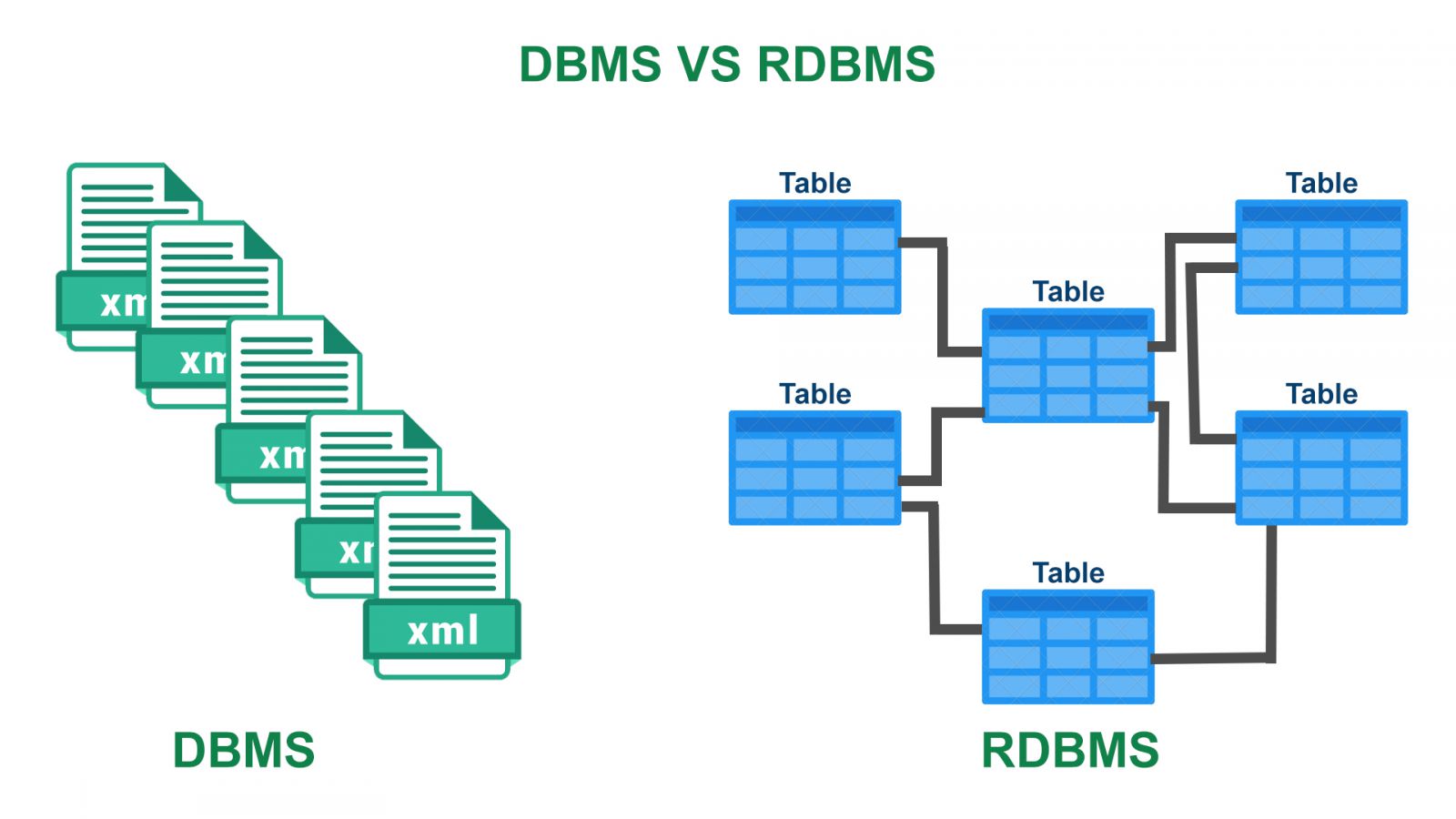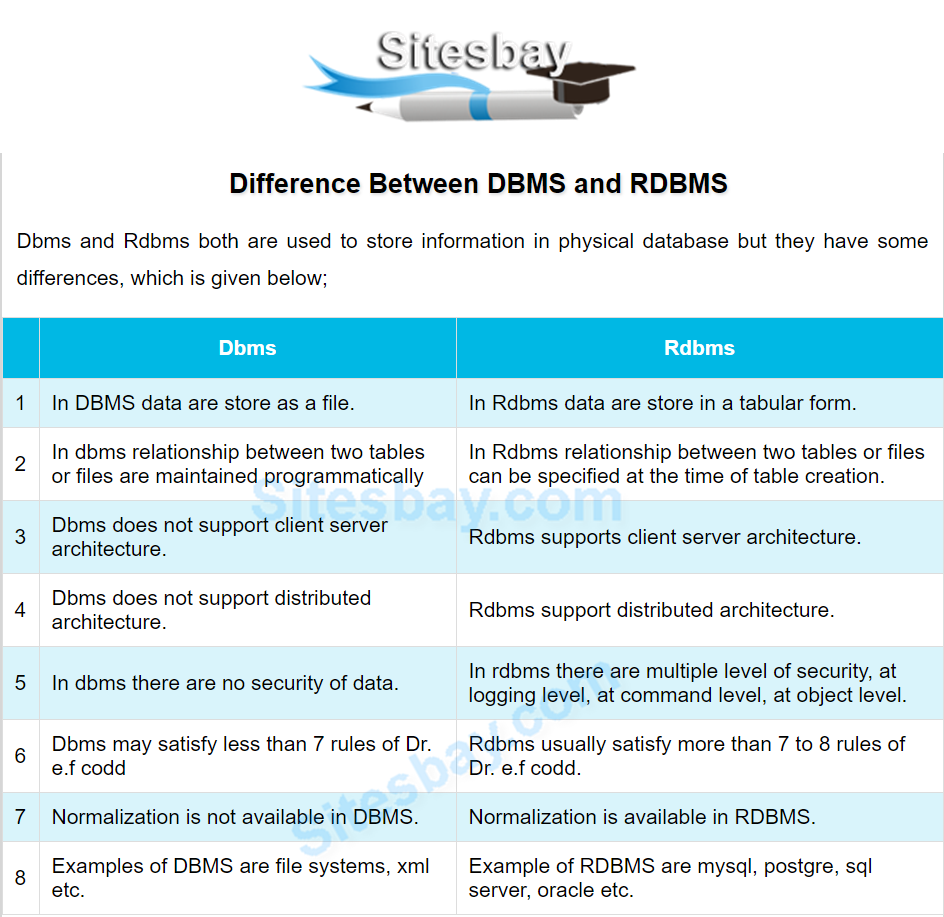Difference Between Dbms and Rdbms Explain With Example
Difference Between DBMS and RDBMS is that DBMS stores data in files but RDBMS stores data in tabular form. DBMS stores data in the form of a file where RDBMS manages data in the form of tables.

Main Difference Between Rdbms And Dbms In Hindi Easy Tutorial Youtube
14 rows RDBMS.

. The main difference between DBMS and RDBMS is that the DBMS is a software that helps to create and manage databases while RDBMS is a type of DBMS that is based on the relational model. DBMS stands for DataBase Management System. The main difference between a DBMS and an RDBMS is DBMS stores data as files while RDBMS stores data in tabular form.
RDBMS deals with large data and generally supports multiple user. U stands for Update. Most of the databases that exist today are an extension of this age old model.
The columns contain information about the attributes characteristics whereas the rows contain all the attributes information about any particular object. DBMS stores data in a navigationalhierarchical form. Thus DBMS files are stored as a code file on the computer whereas RDBMS data is stored in tables.
Database management system here we can store some data and collect. In transaction processing or BI and analytics applications. An RDBMS is a type of database management system with row-based table structure that connects related data elements and includes functions that maintain the accuracy security consistency and integrity of data.
Follows ACID AtomicityConsistencyIntegrityDurability properties for data security. IBMs Information Management System IMS is an example of DBMS and Microsoft SQL Server is an example of RDBMS. To notice the difference between DBMS and RDBMS the DBMS stores data in a file format with a hierarchical or navigational form.
DBMS stores data as file. The RDBMS Relational Database Management System is a system complying to the relational model developed by IBMs E F Codd. We learned that the main difference between DBMS and RDBMS is that DBMS is software that stores and manages data.
D stands for Delete. DBMS is an umbrella term for different types of database management technologies developed over the past 50-plus years. It extends for Relational.
DBMS supports a single user. DBMS accepts the flat file data that means there is no relation among different data whereas RDBMS does not. RDBMS stores data in a tabular structure where the headers are the column names and the rows contain values.
It allows the user to construct modify and administer a relational database. Imagine a single table save and read. RDBMS examples are Oracle MySQL SQL Server and so on.
RDBMS supports multiple users. DBMS can be used for simple applications whereas its next generation design ie. While RDBMS allows multiple users to access a database DBMS only permits one user.
A database management system is software that supports the development administration and use of databases. RDBMS is an advanced version of DBMS. The below table demonstrates the main difference between RDBMS and DBMS.
DBMS stores the data as a file while RDBMS stores the data in the form of tables tabular format. On the other hand RDBMS uses normalization to eliminate the data redundancy. Same as DBMS it stores data but in the form of tables.
DBMS follows a navigational model while RDBMS uses the relational model to. DBMS uses the file format and does not have relational elements. Difference between DBMS and RDBMS.
DBMS examples are XML file systems Windows Registry etc. RDBMS stands for. Relational Database Management here you can join several tables together and get related data and queried data say data for a particular user or for an particular ordernot all users or all orders.
It stands for Database Management System. We can declare that an RDBMS the full form is Relational Database Management System is an. Storage and database structure.
DBMS deals with small data and generally supports single user. On the other hand RDBMS software uses table format where headers are columns and values are rows. Here is the basic difference between DBMS and RDBMS with example.
So in other words a DBMS provides ways for software developers and system users to easily Create Read Update and Delete data from a database. It is a database management system based on the relational model ie. A relational database management system RDBMS is.
So learn DBMS Vs RDBMS with examples. It is used to store data as a file. R stands for Read.
Imagine a single table save and read. RDBMS stands for Relational Database Management System. DBMS vs RDBMS Data in DBMS while stores do not follow ACID model atomicity consistency isolation durability and create inconsistencies in database while RDBMS uses ACID model to manage database and therefore it is well.
RDBMS can be used for complex business applications. RDBMS stores data in tabular form. The data and relationships are represented by a collection of inter-related tables.
The common difference between DBMS and RDBMS is that DBMS just provide an environment where people could conveniently store and retrieve information with in the presence of redundant data. This helps ensure that the data is easily accessibleand is organized consistently in a database. It is a DBMS that enables the user to create update administer and interact with a relational database.
12 rows Data redundancy is common. Data elements need to. It can handle a collection of data and can perform various functionalities such as.
DBMS is a software to manage databases that was introduced during the 1960s. No support for Distributed Databases. The data is structured in database tables fields and records.
While a relational database describes the type of database an RDBMS manages the RDBMS refers to the database program itself. DBMS only support one at a time. RDBMS Relationship among tables is maintained in a RDBMS whereas this not the case DBMS as it is used to manage the database.

Difference Between Dbms And Rdbms With Comparison Chart

Difference Between Dbms And Rdbms

Comments
Post a Comment